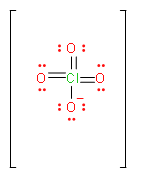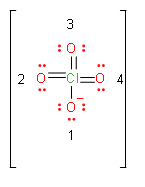
The bond order of \[Cl-O\] bond in \[ClO_{4}^{-}\] ion and the effective charge on each oxygen atom respectively are:
A. 1.75,-1
B. 1.75, -0.25
C. 1.5, -0.5
D. 2.0, -0.5
Answer
429.9k+ views
Hint: To solve these types of questions we should first draw the Lewis structure. And then after it, we then count the number of total bonds and then divide it by the number of elements in which these bonds are made with the central atom.
Step by step answer:
We can solve this question, by first drawing the Lewis dot structure of \[ClO_{4}^{-}\] ion.

In the above figure, the total number of bonds is 7. And if we try to draw different structures, these bonds will rearrange themselves between four elements. Or we can calculate it by counting the number of resonance structures this molecule can make.
$Bond\,order=\dfrac{total\,number\,of\,bonds}{total\,number\,of\,resonance\,structures}$\[\begin{align}
& Formal\text{ }charge\,of\,first\,oxygen=6-6-\dfrac{2}{2}=-1 \\
& Formal\text{ }charge\,of\,\sec ond,\,third\,and\,fourth\,oxygen=6-4-\dfrac{4}{2}=0 \\
\end{align}\]
\[Bond\,order=\dfrac{7}{4}=1.75\]
So, from the above calculation we found that the bond order of perchlorate ion is 1.75.
Now, we will calculate formal charge on each oxygen atom. First we assign numbers to oxygen atoms.

\[Formal\text{ }charge=\text{ }valence\text{ }electrons-unbonded\,electrons-\dfrac{1}{2}bonded\,electrons\]
\[\begin{align}
& Formal\text{ }charge\,of\,first\,oxygen=6-6-\dfrac{2}{2}=-1 \\
& Formal\text{ }charge\,of\,\sec ond,\,third\,and\,fourth\,oxygen=6-4-\dfrac{4}{2}=0 \\
\end{align}\]
So, effective charge on oxygen will become -0.25.
From the above discussion and calculation, we can now say that the answer of this question is option B.
Additional information:
We should know that perchlorate is a chemical compound containing the perchlorate ion \[ClO_{4}^{-}\]. The majority of perchlorates are commercially produced salts. They are mainly used for propellants, exploiting properties as powerful oxidizing agents and to control static electricity in food packaging. Most perchlorates are colourless solids that are soluble in water.
Note: We should also know about bond length. It is defined as the distance between the centres of two covalently bonded atoms. The length of the bond is determined by the number of bonded electrons (the bond order). If bond order is high, there will be stronger pull between two atoms and there will be shorter bond length. Therefore, bond length increases in the following order: triple bond < double bond < single bond.
Step by step answer:
We can solve this question, by first drawing the Lewis dot structure of \[ClO_{4}^{-}\] ion.

In the above figure, the total number of bonds is 7. And if we try to draw different structures, these bonds will rearrange themselves between four elements. Or we can calculate it by counting the number of resonance structures this molecule can make.
$Bond\,order=\dfrac{total\,number\,of\,bonds}{total\,number\,of\,resonance\,structures}$\[\begin{align}
& Formal\text{ }charge\,of\,first\,oxygen=6-6-\dfrac{2}{2}=-1 \\
& Formal\text{ }charge\,of\,\sec ond,\,third\,and\,fourth\,oxygen=6-4-\dfrac{4}{2}=0 \\
\end{align}\]
\[Bond\,order=\dfrac{7}{4}=1.75\]
So, from the above calculation we found that the bond order of perchlorate ion is 1.75.
Now, we will calculate formal charge on each oxygen atom. First we assign numbers to oxygen atoms.

\[Formal\text{ }charge=\text{ }valence\text{ }electrons-unbonded\,electrons-\dfrac{1}{2}bonded\,electrons\]
\[\begin{align}
& Formal\text{ }charge\,of\,first\,oxygen=6-6-\dfrac{2}{2}=-1 \\
& Formal\text{ }charge\,of\,\sec ond,\,third\,and\,fourth\,oxygen=6-4-\dfrac{4}{2}=0 \\
\end{align}\]
So, effective charge on oxygen will become -0.25.
From the above discussion and calculation, we can now say that the answer of this question is option B.
Additional information:
We should know that perchlorate is a chemical compound containing the perchlorate ion \[ClO_{4}^{-}\]. The majority of perchlorates are commercially produced salts. They are mainly used for propellants, exploiting properties as powerful oxidizing agents and to control static electricity in food packaging. Most perchlorates are colourless solids that are soluble in water.
Note: We should also know about bond length. It is defined as the distance between the centres of two covalently bonded atoms. The length of the bond is determined by the number of bonded electrons (the bond order). If bond order is high, there will be stronger pull between two atoms and there will be shorter bond length. Therefore, bond length increases in the following order: triple bond < double bond < single bond.
Recently Updated Pages
Difference Between Crystalline and Amorphous Solid

JEE Main Participating Colleges 2024 - A Complete List of Top Colleges

JEE Main Maths Paper Pattern 2025 – Marking, Sections & Tips

Sign up for JEE Main 2025 Live Classes - Vedantu

JEE Main 2025 Helpline Numbers - Center Contact, Phone Number, Address

JEE Main Course 2025 - Important Updates and Details

Trending doubts
JEE Main 2025 Session 2: Application Form (Out), Exam Dates (Released), Eligibility, & More

JEE Main Exam Marking Scheme: Detailed Breakdown of Marks and Negative Marking

JEE Main 2025: Derivation of Equation of Trajectory in Physics

Electric Field Due to Uniformly Charged Ring for JEE Main 2025 - Formula and Derivation

Types of Solutions

Learn About Angle Of Deviation In Prism: JEE Main Physics 2025

Other Pages
NCERT Solutions for Class 11 Chemistry Chapter 9 Hydrocarbons

JEE Advanced Marks vs Ranks 2025: Understanding Category-wise Qualifying Marks and Previous Year Cut-offs

NCERT Solutions for Class 11 Chemistry Chapter 5 Thermodynamics

Hydrocarbons Class 11 Notes: CBSE Chemistry Chapter 9

NCERT Solutions for Class 11 Chemistry In Hindi Chapter 1 Some Basic Concepts of Chemistry

Thermodynamics Class 11 Notes: CBSE Chapter 5




